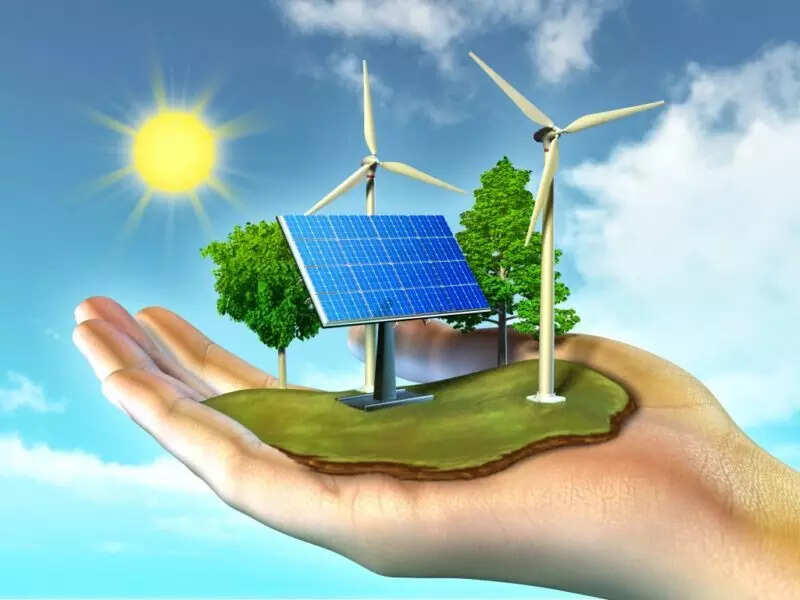 The PM announced a vision of achieving 100pc energy independence by the time India celebrates its 100 years of independence. He elaborated on India’s ambitious renewable energy targets of 450GW to be achieved by 2030. At the recently concluded meetings with UK minister and COP26 President, Alok Sharma, the Indian govt said that the 450GW by 2030 could also be part of the country’s enhanced climate targets under the UN Framework Convention.
The PM announced a vision of achieving 100pc energy independence by the time India celebrates its 100 years of independence. He elaborated on India’s ambitious renewable energy targets of 450GW to be achieved by 2030. At the recently concluded meetings with UK minister and COP26 President, Alok Sharma, the Indian govt said that the 450GW by 2030 could also be part of the country’s enhanced climate targets under the UN Framework Convention.
The Ministry of New and Renewable Energy just last week announced that the total installed renewable energy capacity in India, excluding large hydro, has crossed the mile-stone of 100 GW. The government has launched the Hydrogen Mission with an aim to commercialise hydrogen for industrial use. The Centre and various state governments have announced policies to promote the adoption of electric mobility.
All these latest developments are in clear recognition of the path for energy transition, which the country has embarked on. Looking back, this moment could be the one where India took a big leap towards a clean energy-based future, which will fundamentally change the way the country produces and consumes energy. India could show leadership in building an economy powered by clean energy over the next decade or so.
Having made a jump to 100 GW from 10 GW in a decade and with eyes set on target of achieving another 450GW in the next ten years, is an achievement and vision to be proud of. Several things have aligned in the rapid progress the country has made in the area of installing renewable energy. We have seen political will for renewables; there have been supportive policies implemented; and right technologies have been utilised. Let us understand what should be the path ahead.
There have been some challenges on the road to 100 GW. Financing has been a persistent issue and the international community has done little to facilitate the flow of low-cost debt to India. Also, the fundamental health of India’s power distribution companies remains a challenge. Despite repeated bailouts, most DISCOMS have hardly been able to curtail theft and improve metering efficiencies. Private companies are not able to freely purchase renewables as an option, owing to the monopoly of the state-owned distribution companies.
Till the time round-the-clock supply isn’t ensured through renewables, and battery storage technology doesn’t get sufficiently in reach, thermal power stations will continue to be required by the grid. Good news is that this will certainly change within this decade, and possibly sooner, making new coal build unnecessary.
An urgent national plan is needed to understand if and how India will continue to build thermal assets. Some states in India have gone ahead and announced a “No New Coal” intention. However, it is not immediately clear on how or when this will be implemented. Just considering economics, it is clear that renewables are significantly cheaper than new thermal assets. Therefore, it does not make sense for any distribution company to sign up for new thermal power.
The question is how can existing, inefficient plants be managed. Here, we suggest that only those thermal assets be retained that can help balance the grid. Cost is another critical issue. Most older thermal plants are already depreciated and are among the cheapest sources of power in India (potentially cheaper than existing renewable plants). This raises an issue of an equitable transition, which India must address by ensuring to ramp up energy access to millions insofar underserved.
There is also a role for industry. Indian industry still relies on coal as it is the cheapest fuel for providing large amounts of thermal energy. Significant policy support, like the recent plans to aggregate green hydrogen demand from key industries in sectors of steel, cement and refineries will be a necessary first step to create substantial volumes and facilitate commercial supply of clean energy where most needed. It remain to be seen if hydrogen can indeed come out of the hype and replace coal and fuel oil in major industries across the world.
There are some low hanging fruits which can give quick dividends. Instead of selling renewable power to unwilling DISCOMs, there is an opportunity to ensure that bulk and institutional consumers are able to get clean power. The vision of Indian Railways to attain Net Zero carbon emissions by 2030 is a good example of the possibilities that lie ahead of us.
This vision was possible due to the railways being considered as a ‘deemed licensee’. This helped the railways bypass India’s unwieldy open access regulations and procure power directly from renewable power producers. Such rights, though enshrined in the Electricity act, are not implemented in true spirit, thereby creating an artificial barrier for a market-led development of renewable energy. Aggregating demand and allowing large consumers to directly procure energy, while compensating the grid operators, is known as captive power plants and this exists in the framework of the power sector. However, with high entry barriers, only the largest consumers of electricity choose this path.
Scaling up renewable energy in the next 5- 10 years will mean a focused and holistic approach to the energy sector. This calls for an integrated energy plan with deep decarbonization and equitable transition as its cornerstone. In fact, the Integrated Energy Policy of 2006, aimed to do something similar. Such an integrated approach – both across India’s federal structure as well as across energy demand and supply sectors – needs to be taken in order to meet India’s climate commitments.
